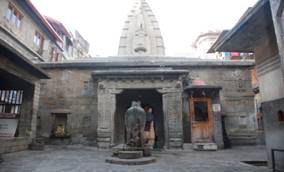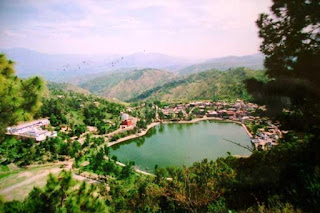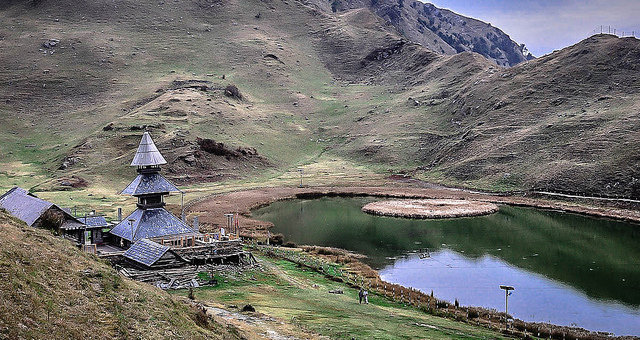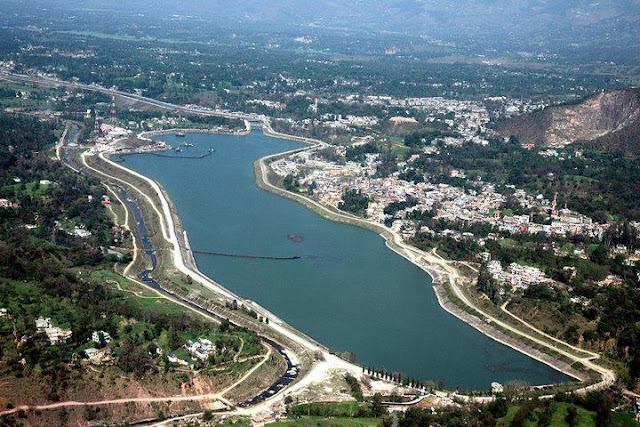Mandi HISTORY: Not much is known about the early history prior to the formation of Suket in 765 AD. The area had been under the control of Ranas or Thakurs. The only place that has an early mention in literature is Rewalsar and it is mentioned in the Skanda Purana as a sacred place of pilgrimage. Karnpur, a small village is said to have been founded by Karan, a hero of the Mahabharta. A temple at Gumma points to the locality where the Pandavas sheltered themselves when the attempt to burn them downfailed. Beyond this not much of the erstwhile state’s existence can be found in classical literature. According to the Tibetan tradition, Padam Sambhav (750-800 AD), the great Buddhist Patriarch, who was summoned by king Tisong-De-Tsen of Tibet for preaching Buddhism, hailed from Zahor, which represents the country round about Rewalsar. On the basis of this it is concluded that Mandi must have been a great place of Buddhist learning about this time.
The present District Of Mandi was formed with the merger of two princely states Mandi and Suket on 15th April 1948, when the State of Himachal Pradesh came into existence. Ever since the formation of the district, it has not witnessd any changes in it’s jurisdiction. The chiefs of Mandi and Suket are said to be from a common ancestor of the Chandravanshi line of Rajputs of Sena dynasty of Bengal and they claim their descent from the Pandavas of the Mahabharata. The ancestors of the line believed to have ruled for 1,700 years in Indarprastha(Delhi), until one Khemraj was driven out by his Wazir, Bisarp, who then took over the throne. Khemraj, having lost his knogdom, fled eastward and settled in Bengal, where 13 of his successors are said to have ruled for 350 years. From there they had to flee to Ropar in Punjab, but here also the king, Rup Sen, was killed and one of his sons, Bir Sen, fled to the hills and reached Suket. The State of Suket is said to have been founded by Bir Sen, an ancestor of the Sena Dynasty of Bengal.
The seperation of Mandi from suket took place about the year 1200 AD. Upto that time, it was the single state of Suket. The then reigning chief Sahu Sen had a quarrel with his younger brother Bahu Sen, who left Suket to seek his fortunes elsewhere. Bahu Sen after leaving Suket settled at Manglan in Kullu, where his descendents lived for 11 generations. Then then chief, Kranchan Sen was killed fighting against the Kullu Raja and his Rani, who was pregnant at that time. fled alone to her father who was the chief of Seokot, who had no son. Here she gave birth to a baby boy who was named Ban, the tree under which he was born. Ban had hardly crossed the age of 15 when he defeated the chief of Kilti who used to plunder travellers.On the death of the chief of Seokot, Ban succeeded to the chiefship of Seokot. He, after some time killed the Rana of Sakor and took posesssion of his lands. he then changed his residence to Bhiu, on the banks of Beas and a few miles from the present Mandi town. Mandi emerged as a seperate state in the begining of the sixteenth century. Down the line of descendants of Ban came Ajbar Sen, nineteenth in descent from Bahu Sen, who founded Mandi Town in 1527 AD, the capital of the erstwhile state of Mandi and the headquarters of the now Mandi District.
Ajbar Sen was the first great ruler of Mandi. He was probably the first to assume the designation of Raja. He consolidated the territories that he had inherited and added to them new ones that he wrested from the hands of his neighbours. He built a palace here and adorned it with four towers. He also built the temple of Bhut Nath and his Rani constructed that of Trilok Nath. Down the line of descendants was Raja Sidh Sen, who succeeded Raja Gur Sen in 1978 AD. Mandi had never been so powerful before his reign and after that never was. He captured great areas from the adjoining areas. it was during his reign that Guru Govind Singh, the tenth guru of the sikhs visited Mandi in the close of the 17th century. He had been imprisoned by Raja singh, the chief of Kullu, from whom he had sought assistance against Mughal troops and his followers believe that Guruji escaped by using miraculous powers. Raja Sidh Sen, who is also considered to be a posessor of great miraculous powers, entertained his with great hospitality. He built the great tank before the palace.
He also built the temples of “Sidh Ganesha” and “Trilokinath”. The entire history of both the states of Mandi and Suket is littered with wars with among themselves and other adjoining states. These two states had always been rivals and generally enemies, but there was no great result of their warfare. The fertile valley of Balh was the common ground of desire and dispute. On 21st February 1846 the chiefs of Mandi and Suket visited Mr. Erskine, Suprintendent of the Hill States for the British Government, owing their allegiance to the Britishers and securing their protection. on 9th march, 1846 a treaty was concluded between the British Government and the Sikh Durbar whereby the whole of the Doab area between the Beas and the Sutlej was ceeded to the British Government, and this included the ststes of Mandi and Suket also. On 1st November 1921, both the state of Mandi and Suket were transferred from the political control of Punjab Government to that of Government of India till 15th August 1947, India’s Independence Day.
Geography:
The district is situated between 31-13-50 and 32-04-30 north latitude and 76-37-20 and 77-23-15 east longitude. It is bounded by Kangra on the north-west, Hamirpur & Bilaspur in the west, Arki tehsil of Solan district in the south, Shimla district in the south-west and Kullu district in the east. The district has 2 main rivers viz. the Beas and the Satluj. The river Beas enters the district from close to Bajaura, at the boundary of Kullu and leaves the district at Sandhol. The Mandi town is also located on the banks of this river. For the greater part of it’s length, it runs between high banks and as it is of never great breadth, the current is swift, especially during the rains. Practically the whole of the district drains into the Beas with only the south-east corner situated on the Satluj watershed.
Rivers and Tributaries:
Within the district the principal tributaries of the Beas on the north bank are Uhl, Luni, Rana and Binu and on the south bank are the Hanse, Tirthan, Bakhli, Jiuni, Suketi, Ranodi, Son and Bakar. The greater part of the district is mountanous terrain with the main ranges of maountains running from the north to the south with the system being broken up by innumerable transverse spurs. The most conspicuous is the Jalori range which is crossed by a high road from from Kullu to Shimla by a pass named as Jalori pass. It divides the watersheds of the Satluj and the Beas and on it’s northern slopes is unusually well wooded with deodar and blue pine forests of great value. the highest peak in the range is Shikari Devi (11,060 feet), it’s summit being crowned by a shrine to a local goddess. The range throws off three main spurs which extend throughout the tract known as the Mandi Saraj. To the north of the Beas is the Nargu range, a continuation of the Bir Bhangal, seperating Mandi from Kullu proper and crossed by the Bhubu pass (9,480 feet). The mountains here run upto 13000 feet, the slopes often being very precipitous and the valleys deep.
Mountains :
 Almost parallel and running down the centre of the district is the Ghoghar-Ki-Dhar, of which the slopes are fairly gentle. It is not well wooded, but contains large expanses of excellent grazing and the salt quarries of Drang and Guman. The Sikandar Range commences from the trijunction with Suket and Bilaspur and from there runs northward for fifty miles. The range contains some good forests of chil pine. but the greater part of it consists of rich grass slopes. It’s name is attributed to Sikander Lodhi, who, 375 years before the reign of Akbar, is supposed to have crossed it on his way to the conquest of Kangra. The range of altitudes in the district is high, with the highest point being around 13,000 feet on the Kullu border and the lowest point 1,800 feet near Sandhol where the Beas leaves the district. The only area which is similar to the plains is the Balh valley. Several of the valleys are open and are often irrigable from kuhls, or small water channels, and contain some of the most fertile land in the state. Due to the hilly terrain, some of the hills are so precipitous that cultivation in large scale is impossible.
Almost parallel and running down the centre of the district is the Ghoghar-Ki-Dhar, of which the slopes are fairly gentle. It is not well wooded, but contains large expanses of excellent grazing and the salt quarries of Drang and Guman. The Sikandar Range commences from the trijunction with Suket and Bilaspur and from there runs northward for fifty miles. The range contains some good forests of chil pine. but the greater part of it consists of rich grass slopes. It’s name is attributed to Sikander Lodhi, who, 375 years before the reign of Akbar, is supposed to have crossed it on his way to the conquest of Kangra. The range of altitudes in the district is high, with the highest point being around 13,000 feet on the Kullu border and the lowest point 1,800 feet near Sandhol where the Beas leaves the district. The only area which is similar to the plains is the Balh valley. Several of the valleys are open and are often irrigable from kuhls, or small water channels, and contain some of the most fertile land in the state. Due to the hilly terrain, some of the hills are so precipitous that cultivation in large scale is impossible.Famous Temples and Lakes in Mandi
Dev Balakameshwar Temple:
Himachal Pradesh – ‘The Land of Gods’ , famous by the name ‘devbhoomi’ all over the world. This state is said to be protected and sheltered by the power of numerous local deities. These deities possess some peculiar personality traits and have their own individual entity. Every region in Himachal believes in a distinct deity. All the faith of the local people is vested in these local gods called ‘devta’ in the regional language.Some of the deities and their characteristics that distinguish them from each other are discussed below- Dev Balakameshwar temple is 13 km from Mandi and located in its very heart,Practically synonymous with Mandi located in its very heart Dev Balakameshwar Temple,located in village & po tikkar.
Triloknath Temple:
It is a Shiva temple erected in stone in the Shikhara style. The cella contains a lefe-sized three faced stone image of Shiva who is riding on a bull with Parvati in his lap. There is also a second image, probably of Shiva, which is much worn out. The workman throughout is good but the carving has suffered much from neglect and is much worn owing to the soft nature of the sandstone employed but is still one of the finest monuments. The image which it enshrines is connected with the rite of Sati, in which a woman whose husnabd would die would burn herself on the funral pire. Such a woman was brought to the temple before she mounted the pire and was shown the face at the back of the idol.
Bhootnath Temple:
Practically synonymous with Mandi and located in its very heart, Bhootnath Temple is as old as the town itself and dates to the 1520s. In March, the festival of Shivratri is a major event and the Bhootnath Temple is its focus. For an entire week, the town celebrates the arrival of hundreds of local deities on elaborately decorated palanquins.The most popular shrine in Mandi is that of Bhuth Nath who is venerated as the guardian of the town and represents Shiva in his attributes. The temple is of stone in the Shikara style, consisting of a small porch
and cella surmounted by a spire. The sabha mandap in front is apperently and addition. The porch is supported by fluted pillars with capitals carved in elephants, the arch between being trefoil.
Panchvaktra Temple:
At the confluence of the Beas and Suketi is a Shikara temple evidently of considerable age and dedicated to Shiva, under the name of Panchvaktra (the five-faced one). the main porch or mandap is supported on four heavy pillars, the capitals of which are carved in flower-pot design and the bases in rosettes of lAt the confluence of the Beas and Suketi is a Shikhara temple evidently of considerable age and dedicated to Shiva, under the name of Panchvaktra (the five-faced one). the main porch or mandap is supported on four heavy pillars, the capitals of which are carved in flower-pot design and the bases in rosettes of lotuses. The main image is of some interest, since the five faces are not placed in one row as is usually the case with polycephalic statues, but in such a way that the fourth face is on the reverse side of the slab which is otherwise quite plain and fifth on top of the image slab. thus when seen from the front, only three faces are visible. The number of arms is ten. Such images of the five-faced Shiva are not uncommon in Mandi.
Rewalsar Lake:
About 25 km from Mandi, 14 km from Ner Chowk is the Rewalsar lake, famous for its floating islands of reed. It is believed that all seven of them can be moved by prayer or breeze. There are three shrines here, a Buddhist monastery, where elaborate rituals are performed, a Sikh gurudwara and a Hindu temple. It was from this place that the sage Padma Sambhava, a zealous teacher of Buddhism, left as a missionary to preach the doctrine of “the enlightened” in Tibet. Lying in a mountain hollow, the lake is held sacred to all three communities; boating facilities are available. Tourist inn maintained by HPTDC provide accommodation and Indian cuisine.
Prashar Lake:
Prashar Lake lies 49 km north of Mandi, with a three-storied pagoda-like temple dedicated to the sage Prashar.
Macchial Lake:
Macchial Lake is a low altitude lake which is situated in Mandi district (7 km from the Jogindernagar town). This lake is considered sacred and is named after Macchendru Devta or Matasya Avtar of Lord Vishnu.
Joginder Nagar:
The large hydro-electric project in Joginder Nagar has an electric trolley takes the visitor up the steep, rocky face of 2,500 metres-high (8,202 ft) mountain and drops sharply on the other side to Barot, where the reservoir is.
The railway line goes up to the power station, the water rushing down from the reservoir at Barot in the Uhl river through penstock pipes going down nearly a thousand metres (3,280 ft). For tourists who go up to Barot by the trolley, there is a comfortable rest house of the electricity department. The roads extend beyond to Mandi and passes the Larji gorge to the Kullu valley.
Bassi power station is 8 kilometres from Jogindernagar. Next to it is Machhial where fishing is not permitted as it is considered a holy sacred spot. It is a popular as a feeding spot for fish.
Ladh-bharol: 25 km from Joginder Nagar very beautiful town, santan datri ma simsa mata mandir in nearby Lad-bharol, 7 km from Ladh-bharol, Nageshwar Mahadev Coudh is near Bharol. The Triveni Mahadev where three rivers Bias, Binwa and one local are meeting with each other. A very ancient Lord shiva temple is there and very scenic beauty of the intersecting of three rivers.
Santan Datri Man Shimsha (Sharda) is at Village Shimashjust on the top of hill of Triveni Mahadev. Childless women pray and sleep inside the temple in Navratras and man blessed them with different fruits indicating boy or girl.
Nageshwar Mahadev Kud is in the foothills of village shimash and there is ancient goofa in which lot of natural shivlings. A unique and natural combined shivling of Shiva and Parvati, a unique and natural Sculpture of Nandi Bail and finally a unique and natural shivling with NAG; that is why it is known as Nageshwar Mahadev.
Sunder Nagar:
Famous for its temples, 26 km from Mandi towards Shimla and at a height of 1,174 metres on the raised edge of a fertile valley, the beautiful town of Sunder Nagar is known for its shady walks amidst towering trees. On top of a hill and visited by thousands of devotees every year, is the Sukhdev Vatika and temple of Mahamaya.
The biggest hydro-electric project in all Asia, the Beas-Sutlej project, irrigating nearly one-fourth of the northern plains of India, has brought unprecedented prosperity to Sunder Nagar. The Beas-Sutlej link colony is the biggest colony in Himachal Pradesh.
Janjehli:
At a distance of 80 km from Mandi, Janjehli is a paradise for hikers, offering treks up to a height of 3,300 metres. All the road is motorable and fun to ride. The road is connected to Karsog which remains open all seasons except some weeks of winter. It takes about 3 hours to reach here from Mandi via Baggi, Chail Chowk and Thunag (Tehsil Headquarters). In the midst of thick forest, forests (15 km from Gohar) is Bajahi. There is a beautiful and well-furnished rest house to stay overnight. From here Janjehli is a scant 20 km away through bridle path. Chindi and Karsog are nice places for meditation. Janlehli is popular for adventure activities like-trekking, night safari, mountneering, skiing etc. At the distance of 10 km from janjehli is the Shikari Mata temple.
The temple is all about Goddess “Shikari Devi” and people visits here in masses to accolades for their well being. It is a beautiful and scenic place with mountains which seem to be avoiding each other but the clouds more often get them in touch. Thunag is a beautiful place to visit, despite Tehsil Headquarters it is home to a stunning rest house with glorious location and thick canopy of Deodars, addition to that native land of Sh. Jai Ram Thakur (MLA & Incumbent State Minister). Jarol is beautiful place between Janjehli and Thunag.
Barot:
Barot is a picnic spot and tourist location in Mandi district in the Indian state of Himachal Pradesh. It is situated 40 km from Jogindernagar and 66 km from Mandi, the district headquarters. The road to Barot branches off at Jogindernagar-Mandi high ways and from Jogindernagar the distance is 40 km. It is sometimes possible to use the trolley from Jogindernagar which reduces the distance to 12 km. The route includes terraced fields and thick cedar forests, rising to Jhatingri at the hilltop. The remains of the summer palace of the former rulers of Mandi are located here.Through the little village of Tikkan, the road carries on to Barot. The town has a range of outdoor activities, including a trout breeding centre from where fish are released into the Uhl. A 30 km section of the river is used for angling.
Barot also forms the gateway to the Nargu Wildlife Sanctuary which lies across the Uhl. The sanctuary is home to the monal, black bear and ghoral. Within it are forest rest houses at Thaltuckhod and Silbandhwari. Through woods of cedar and pine a trek route cuts across the sanctuary to Kullu.
Kotli:
At a distance of 22 km from Mandi (Mandi-Jalandhar NH-70) is a sub-tehsil of Mandi district. Arnodi “khadd” flows along the tungal valley to meet the river Beas at kun ka tar. Famous temples are Shiv temple Kotli, Racehra dev temple kotli and Racehra hill, Janitri devi Temple at Janitri Hill, Jhagru Dev Temple, Kasla dev and kamrawh dev temple kotli, surgani devi temple, Mahan Dev temple, Tej bahadur singh Temple, troka wali devi temple, and Nagni devi temple.. Famous fairs are the Saigaloo, Mahan Dev, and Janitri Devi.
Other Places and Temples:
- Sunken Garden (Indira Market)
- Tarna Temple, also called Shyama Kali temple
- Bhima Kali Temple
- Kamlah-Fort
- Vishvakarma temple How to Reach:
Train: Nearest Railway Stations are Joginder Nagar and Shimla.
Road- By using NH 21 national Highway.







